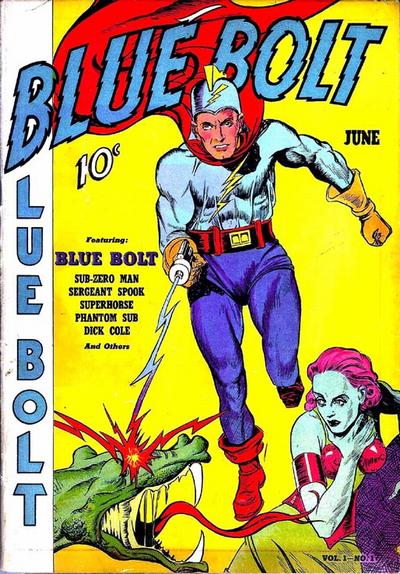In the hectic early days of the Golden Age of comics the demand for new material seemed to far outstrip the ability of the talent to produce it. It was a mismatch in the marketplace of cheap offerings keeping the really fine talent out. That left youth. It was they up and coming youngsters from the close confines of New York City who fill the gap. They worked for small money in an industry which barely seemed to know it existed, but was beginning to capture the public imagination.
Into this atmosphere stepped Joe Simon, a savvy and talented artist who had honed his skills, such as they were, in local newspapers and as part of studios which supplied talent to the shark-like publishers who were entering the new field. Victor Fox was perhaps the most shark-like of all of them, a self-important loudmouth who called himself "The King of Comics".
His staff made fun of that remark and it became an ironic catchphrase many years later. Simon impressed Fox and was soon producing Blue Bolt, a comic which evoked the essence of the time, namely the science fiction serials such as Flash Gordon and Buck Rogers.
In the debut issue of Blue Bolt we meet Fred Parrish, the obligatory football hero who is struck by lightning and finds his way into a weird underground world dubbed Deltos. There he is infused with more lightning power which makes him effectively superhuman with great strength and the ability to fly. He dons a blue costume and with little reflection on the life he left appears to pledge allegiance to the scientist to who made him. The "Scientific City" is in a war with the Green Army led by the alluring Green Sorceress.
The second issue of Blue Bolt brings with it a new flavor as the artwork seems more energetic and alive. That's no accident, as the second Blue Bolt adventure is the first published work by the Joe Simon and Jack Kirby team. Simon seemed well aware what a consummate talent he had discovered with Kirby and was very savvy to hitch his horse to such an artist. Simon's skills were not insignificant as an artist and his skills as a writer and businessman were quite advanced for the time period.
The struggle between Blue Bolt and the Green Sorceress is one of those classic frictions in which there is romantic attraction in combination with fundamental differences in politics. The Sorceress wants to rule of of the tiny world of Deltos and Blue Bolt in service to Dr. Bertoff stands in her way.
The schemes switch back and forth and the Sorceress is captured and then escapes. The story is told not unlike a serial, owing much to its movie inspirations. Each chapter sets up a high-concept bit, but by the end the story is either reset or ends on something akin to a cliffhanger.
Blue Bolt was something of a hit, though Simon and Kirby left the series after ten episodes or thereabouts. The title ran for many years and the character showed up from time to time. Reading these yarns felt at times more like watching the Flash Gordon serials than even reading the original Alex Raymond material which those were based on. Simon and Kirby really tap into that movie vibe quite successfully.
Rip Off











If you read interviews from artists who were around at the time, you get an inkling of the powerful influence of Raymond's Flash Gordon, which ignited the fantasies of two or three generations, and is a prime source for everything from Superman's costume to Frazetta's brush strokes. The Green Sorceress is a figure just as potently erotic as Princess Aura and Azura the Witch Queen; Simon and Kirby were both still single and at an age when women drive you stupid crazy, and it added heat to this first collaboration.
ReplyDeleteThe Flash Gordon influence is strong in this outing and to their great credit, Simon and Kirby really give their version an out-sized sci-fi feel. The Sorceress is a looker indeed -- Gamora anyone?
DeleteRip Off
Here's an even more obvious influence on Gamora:https://www.bleedingcool.com/2014/11/21/swipe-file-a-stranger-in-hell-and-gamora/
Delete